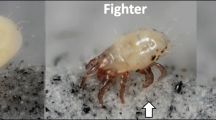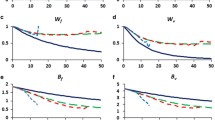Abstract
We compared the efficacy of artificial and natural selection processes in purging the genetic load of perpetually small populations. We subjected replicate lines of the housefly (Musca domestica L.), recently derived from the wild, to artificial selection for increased mating propensity (i.e., the proportion of male–female pairs initiating copulation within 30 min) in efforts to cull out the inbreeding depression effects of long-term small population size (as determined by a selection protocol for increased assortative mating). We also maintained parallel non-selection lines for assessing the spontaneous purge of genetic load due to inbreeding alone. We thus evaluated the fitness of artificially and ‘naturally’ purging populations held at census sizes of 40 individuals over the course of 18 generations. We found that the artificially selected lines had significant increases in mating propensity (up to 46% higher from the beginning of the protocol) followed by reversed selection responses back to the initial levels, resulting in non-significant heritabilities. Nevertheless, the ‘naturally’ selected lines had significantly lower fitness overall (a 28% reduction from the beginning of the protocol), although lower effective population sizes could have contributed to this effect. We conclude that artificial selection bolstered fitness, but only in the short-term, because the inadvertent fixation of extant genetic load later resulted in pleiotropic fitness declines. Still, the short-term advantage of the selection protocol likely contributed to the success of the speciation experiment since our recently-derived housefly populations are particularly vulnerable to inbreeding depression effects on mating behavior.
Similar content being viewed by others
References
J.D. Ballou (1997) ArticleTitleAncestral inbreeding only minimally affects inbreeding depression in mammalian populations J. Hered. 88 169–178 Occurrence Handle9183845 Occurrence Handle1:STN:280:ByiA38jgsFw%3D
R. Bijlsma J. Bundgaard A.C. Boerema (2000) ArticleTitleDoes inbreeding affect the extinction risk of small populations? Predictions from Drosophila J. Evol. Biol. 13 502–514 Occurrence Handle10.1046/j.1420-9101.2000.00177.x
R. Bijlsma J. Bundgaard W.F. Putten Particlevan (1999) ArticleTitleEnvironmental dependence of inbreeding depression and purging in Drosophila melanogaster J. Evol. Biol. 12 1125–1137 Occurrence Handle10.1046/j.1420-9101.1999.00113.x
B.A. Brewer R.C. Lacy M.L. Foster G. Alaks (1990) ArticleTitleInbreeding depression in insular and central populations of Peromyscus mice J. Hered. 81 257–266 Occurrence Handle2273239 Occurrence Handle1:STN:280:By6C3cfgtFE%3D
E.H. Bryant L.M. Meffert S.A. McCommas (1990) ArticleTitleFitness rebound in serially bottlenecked populations of the house fly Am. Nat. 136 543–549 Occurrence Handle10.1086/285112
M.G. Bulmer (1971) ArticleTitleThe effect of selection on genetic variability Am. Nat. 105 201–211 Occurrence Handle10.1086/282718
B. Burnet K. Connolly (1974) Activity and sexual behaviour in Drosophila melanogaster J.H.F. Abeelen Particlevan (Eds) The Genetics of Behaviour North-Holland Publishing The Netherlands 201–258.
D.L. Byers D.M. Waller (1999) ArticleTitleDo plant populations purge their genetic load? Effects of population size and mating history on inbreeding depression Annu. Rev. Ecol. Syst. 30 479–513 Occurrence Handle10.1146/annurev.ecolsys.30.1.479
A. Caballero M.A. Toro C. López-Fanjul (1991) ArticleTitleThe response to artificial selection from new mutations in Drosophila melanogaster Genetics 127 89–102
B. Charlesworth (1998) ArticleTitleThe effect of synergistic epistasis on the inbreeding load Genet. Res. Camb. 71 85–89 Occurrence Handle1:STN:280:DyaK1czjvFWqsg%3D%3D
B. Charlesworth D. Charlesworth (1987) ArticleTitleInbreeding depression and its evolutionary consequences Annu. Rev. Ecol. Syst. 18 237–268 Occurrence Handle10.1146/annurev.es.18.110187.001321
P. Crnokrak S.C.H. Barrett (2002) ArticleTitlePerspective: purging the genetic load: a review of the experimental evidence Evolution 56 2347–2358 Occurrence Handle12583575 Occurrence Handle10.1554/0014-3820(2002)056[2347:PPTGLA]2.0.CO;2
J.F. Crow (1993) Mutation, mean fitness, and genetic load D. Futuyma J. Antonovics (Eds) in Oxford Surveys in Evolutionary Biology Oxford University Press Oxford 3–42
Crow, J.F. & N.E. Morton, 1955. Measurement of gene frequency drift in small populations. Evolution : 202–214.
S.B. Day E.H. Bryant L.M. Meffert (2003) ArticleTitleThe influence of variable rates of inbreeding on fitness, environmental responsiveness, and evolutionary potential Evolution 57 1314–1324 Occurrence Handle12894939 Occurrence Handle10.1554/02-713
M.R. Dudash D.E. Carr C.B. Fenster (1997) ArticleTitleFive generations of enforced selfing and outcrossing in Mimulus guttatus: inbreeding depression variation at the population and family level Evolution 51 54–65 Occurrence Handle10.2307/2410960
D.S. Falconer (1989) Introduction to Quantitative Genetics EditionNumber2nd edn. Longman New York
A. Faugeres C. Petit E. Thibout (1971) ArticleTitleThe components of sexual selection Evolution 25 265–275 Occurrence Handle10.2307/2406917
R. Frankham (1995a) ArticleTitleInbreeding and extinction: a threshold effect Conserv. Biol. 9 792–799 Occurrence Handle10.1046/j.1523-1739.1995.09040792.x
R. Frankham (1995b) ArticleTitleConservation genetics Annu. Rev. Genet. 29 305–327 Occurrence Handle1:CAS:528:DyaK28XlsFOm Occurrence Handle10.1146/annurev.ge.29.120195.001513
R. Frankham D.M. Gilligan D. Morris D.A. Briscoe (2001) ArticleTitleInbreeding and extinction: effects of purging Conserv. Genet. 2 279–285 Occurrence Handle10.1023/A:1012299230482
R. Frankham B.H. Yoo B.L. Sheldon (1988) ArticleTitleReproductive fitness and artificial selection in animal breeding: culling on fitness prevents a decline in reproductive fitness in lines of Drosophila melanogaster selected for increased inebriation time Theor. Appl. Genet. 76 909–914 Occurrence Handle10.1007/BF00273680
N. García C. López-Fanjul A. García-Dorado (1994) ArticleTitleThe genetics of viability in Drosophila melanogaster: effects of inbreeding and artificial selection Evolution 48 1277–1285 Occurrence Handle10.2307/2410385
P.W. Hedrick (1994) ArticleTitlePurging inbreeding depression and the probability of extinction: full-sib mating J. Hered. 73 363–372
W.G. Hill A. Caballero (1992) ArticleTitleArtificial selection experiments Annu. Rev. Ecol. Syst. 23 287–310 Occurrence Handle10.1146/annurev.es.23.110192.001443
M.J. Hollingsworth J. Maynard Smith (1955) ArticleTitleThe effects of inbreeding on rate of development and on fertility in Drosophila subobscura J. Genet. 53 295–314 Occurrence Handle10.1007/BF02993984
P.D. Keightley W.G. Hill (1992) ArticleTitleQuantitative genetic variation in body size of mice from new mutations Genetics 131 693–700 Occurrence Handle1628812 Occurrence Handle1:STN:280:By2A3s7ptVI%3D
A.S. Kondrashov (1995) ArticleTitleContamination of the genome by very slightly deleterious mutations: why have we not died 100 times over? J. Theor. Biol. 175 583–594 Occurrence Handle7475094 Occurrence Handle1:STN:280:BymD3s%2FpsFc%3D Occurrence Handle10.1006/jtbi.1995.0167
R.L. Lacy G. Alaks A. Walsh (1996) ArticleTitleHierarchical analysis of inbreeding depression in Peromyscus polionotus Evolution 50 2187–2200 Occurrence Handle10.2307/2410690
R.C. Lacy J.D. Ballou (1998) ArticleTitleEffectiveness of selection in reducing the genetic load in populations of Peromyscus polionotus during generations of inbreeding Evolution 52 900–909 Occurrence Handle10.2307/2411285
R. Lande (1994) ArticleTitleRisk of population extinction from new deleterious mutations Evolution 48 1460–1469 Occurrence Handle10.2307/2410240
R. Lande (1995) ArticleTitleMutation and conservation Conserv. Biol. 9 782–791 Occurrence Handle10.1046/j.1523-1739.1995.09040782.x
R. Lande D.W. Schemske S.T. Schultz (1994) ArticleTitleHigh inbreeding depression, selective interference among loci, and the threshold selfing rate for purging recessive lethal mutations Evolution 48 965–978 Occurrence Handle10.2307/2410359
B.D.H. Latter J.C. Mulley (1995) ArticleTitleGenetic adaptation to captivity and inbreeding depression in small laboratory populations of Drosophila melanogaster Genetics 139 255–266 Occurrence Handle7705628 Occurrence Handle1:STN:280:ByqB38%2Fms1E%3D
B.D.H. Latter J.C. Mulley D. Reid L. Pascoe (1995) ArticleTitleReduced genetic load revealed by slow inbreeding in Drosophila melanogaster Genetics 139 287–297 Occurrence Handle7705630 Occurrence Handle1:STN:280:ByqB38%2Fms1M%3D
M. López C. López-Fanjul (1993) ArticleTitleSpontaneous mutation for a quantitative trait in Drosophila melanogaster Genet. Res. Camb. 61 107–116
C. López-Fanjul A. Fernandez M.A. Toro (2000) ArticleTitleEpistasis and the conversion of non-additive genetic variance at population bottlenecks Theor. Popul. Biol. 58 49–59 Occurrence Handle10944475 Occurrence Handle10.1006/tpbi.2000.1470
C. López-Fanjul A. Villaverde (1989) ArticleTitleInbreeding increases genetic variance for viability in Drosophila melanogaster Evolution 43 1800–1804 Occurrence Handle10.2307/2409394
M. Lynch J. Connery R. Bürger (1995) ArticleTitleMutational meltdowns in sexual populations Evolution 49 1067–1080 Occurrence Handle10.2307/2410432
T.A. Markow (1981) ArticleTitleCourtship behavior and control of reproductive isolation between Drosophila mojavensis and Drosophila arizonensis Evolution 35 1022–1026 Occurrence Handle10.2307/2407873
D. McCall M. Waller T. Mitchell-Olds (1994) ArticleTitleEffects of serial inbreeding on fitness components in Impatiens capensis Evolution 48 818–827 Occurrence Handle10.2307/2410489
L.M. Meffert E.H. Bryant (1991) ArticleTitleMating propensity and courtship behavior in serially bottlenecked lines of the housefly Evolution 45 293–306 Occurrence Handle10.2307/2409664
L.M. Meffert E.H. Bryant (1992) ArticleTitleDivergent ambulatory and grooming behavior in serially bottlenecked lines of the housefly Evolution 46 1399–1407 Occurrence Handle10.2307/2409945
L.M. Meffert J.L. Regan (2002) ArticleTitleA test of speciation via sexual selection on female preferences Anim. Behav. 64 955–965 Occurrence Handle10.1006/anbe.2002.2020
L.M. Meffert J.L. Regan B.W. Brown (1999) ArticleTitleConvergent evolution of the mating behaviour of founder-flush populations of the housefly J. Evol. Biol. 12 859–868 Occurrence Handle10.1046/j.1420-9101.1999.00105.x
P.S. Miller P.W. Hedrick (2001) ArticleTitlePurging of inbreeding depression and fitness decline in bottlenecked populations of Drosophila melanogaster J. Evol. Biol. 14 595–601 Occurrence Handle10.1046/j.1420-9101.2001.00303.x
A.Ø. Mooers H.D. Rundle M.C. Whitlock (1999) ArticleTitleThe effects of selection and bottlenecks on male mating success in peripheral isolates Am. Nat. 153 437–444 Occurrence Handle10.1086/303186
P.A. Parsons (1974) ArticleTitleMating speed as a component of fitness in Drosophila Behav. Genet. 4 395–404 Occurrence Handle4433314 Occurrence Handle1:STN:280:CSqD2Mvht1A%3D Occurrence Handle10.1007/BF01066159
A. Poon S.P. Otto (2000) ArticleTitleCompensating for our load of mutations: freezing the meltdown of small populations Evolution 54 1467–1479 Occurrence Handle11108576 Occurrence Handle1:STN:280:DC%2BD3MzgsVOntQ%3D%3D Occurrence Handle10.1554/0014-3820(2000)054[1467:CFOLOM]2.0.CO;2
D. Reed E.H. Bryant (2001) ArticleTitleFitness, genetic load and purging in experimental populations of the housefly Conserv. Genet. 2 57–62 Occurrence Handle10.1023/A:1011567018530
D.H. Reed E.H. Lowe D.A. Briscoe R. Frankham (2003) ArticleTitleInbreeding and extinction: effects of rate of inbreeding Conserv. Genet. 4 405–410 Occurrence Handle1:CAS:528:DC%2BD3sXktlagsLc%3D Occurrence Handle10.1023/A:1024081416729
J.L. Regan L.M. Meffert E.H. Bryant (2003) ArticleTitleA direct experimental test of founder-flush effects on the evolutionary potential for assortative mating J. Evol. Biol. 16 302–312 Occurrence Handle14635869 Occurrence Handle1:STN:280:DC%2BD3srlsFyjtA%3D%3D Occurrence Handle10.1046/j.1420-9101.2003.00521.x
A. Robertson (1952) ArticleTitleThe effect of inbreeding on the variation due to recessive genes Genetics 37 189–207 Occurrence Handle17247385 Occurrence Handle1:STN:280:DC%2BD2s%2FmsFelsw%3D%3D
S.T. Rodríguez-Ramilo A. Pérez-Figeroa B. Fernández J. Fernandez A. Caballero (2004) ArticleTitleMutation-selection balance accounting for genetic variation for viability in Drosophila melanogaster as deduced from an inbreeding and artificial selection experiment J. Evol. Biol. 17 528–541 Occurrence Handle15149396 Occurrence Handle10.1111/j.1420-9101.2004.00707.x
M.R. Rose (1984) ArticleTitleArtificial selection on a fitness component in Drosophila melanogaster Evolution 38 516–526 Occurrence Handle10.2307/2408701
I.J. Saccheri P.M. Brakefield R.A. Nichols (1996) ArticleTitleSevere inbreeding depression and rapid fitness rebound in the butterfly Bicyclus anynana (Satyridae) Evolution 50 2000–2013 Occurrence Handle10.2307/2410758
SAS 1988. SAS Institute, Inc. Cary, North Carolina
S. Schultz M. Lynch (1997) ArticleTitleMutation and extinction: the role of variable mutational effects, synergistic epistasis, beneficial mutations, and degree of outcrossing Evolution 51 1363–1371 Occurrence Handle10.2307/2411188
P.M. Sharp (1984) ArticleTitleThe effect of inbreeding on competitive male-mating ability in Drosophila melanogaster Genetics 106 601–612 Occurrence Handle17246200
D. Spielman R. Frankham (1992) ArticleTitleModeling problems in conservation genetics using captive Drosophila populations: improvement of reproductive fitness due to immigration of one individual into small partially inbred populations Zoo. Biol. 11 343–351 Occurrence Handle10.1002/zoo.1430110506
N.W. Thornhill (1993) The Natural History of Inbreeding and Outbreeding: Theoretical and Empirical Perspectives University of Chicago Press Chicago
C. Oosterhout Particlevan G. Smit M.K. Heuven Particlevan P.M. Brakefield (2000a) ArticleTitlePedigree analysis on small laboratory populations of the butterfly Bicyclus anynana: the effects of selection on inbreeding and fitness Conserv. Genet. 4 321–328 Occurrence Handle10.1023/A:1011586612284
C. Oosterhout Particlevan W.G. Zijlstra M.K. Heuven P.M. Brakefield (2000b) ArticleTitleInbreeding depression and genetic load in laboratory populations of the butterfly Bicyclus anynana Evolution 54 218–225 Occurrence Handle10.1554/0014-3820(2000)054[0218:IDAGLI]2.0.CO;2
M.J. Wade S.M. Shuster L. Stevens (1996) ArticleTitleInbreeding: its effect on response to selection for pupal weight and the heritable variance in fitness in the flour beetle, Tribolium castaneum Evolution 50 723–733 Occurrence Handle10.2307/2410845
J. Wang (2000) ArticleTitleEffects of population structures and selection strategies on the purging of inbreeding depression due to deleterious mutations Genet. Res. Camb. 76 75–86 Occurrence Handle1:STN:280:DC%2BD3cvltF2ktA%3D%3D
J. Wang W.G. Hill D. Charlesworth B. Charlesworth (1999) ArticleTitleDynamics of inbreeding depression due to deleterious mutations in small populations: mutation parameters and inbreeding rate Genet. Res. Camb. 74 165–178 Occurrence Handle1:STN:280:DC%2BD3c%2FltF2nug%3D%3D
M.C. Whitlock (2000) ArticleTitleFixation of new alleles and the extinction of small populations: drift load, beneficial alleles, and sexual selection Evolution 54 1855–1861 Occurrence Handle11209765 Occurrence Handle1:STN:280:DC%2BD3M3jt1KjsA%3D%3D Occurrence Handle10.1554/0014-3820(2000)054[1855:FONAAT]2.0.CO;2
M.C. Whitlock P.C. Phillips M.J. Wade (1993) ArticleTitleGene interaction affects the additive genetic variance in subdivided populations with migration and extinction Evolution 47 1758–1769 Occurrence Handle10.2307/2410219
J.H. Willis H.A. Orr (1993) ArticleTitleIncreased heritable variation following population bottlenecks: the role of dominance Evolution 47 949–956 Occurrence Handle10.2307/2410199
Author information
Authors and Affiliations
Corresponding author
Rights and permissions
About this article
Cite this article
Meffert, L.M., Regan, J.L. Reversed selection responses in small populations of the housefly (Musca domestica L.). Genetica 127, 1–9 (2006). https://doi.org/10.1007/s10709-005-2913-2
Received:
Accepted:
Issue Date:
DOI: https://doi.org/10.1007/s10709-005-2913-2




